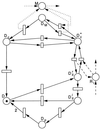Quantitative modeling of stochastic systems in molecular biology by using stochastic Petri nets
- PMID: 9618484
- PMCID: PMC22622
- DOI: 10.1073/pnas.95.12.6750
Quantitative modeling of stochastic systems in molecular biology by using stochastic Petri nets
Abstract
An integrated understanding of molecular and developmental biology must consider the large number of molecular species involved and the low concentrations of many species in vivo. Quantitative stochastic models of molecular interaction networks can be expressed as stochastic Petri nets (SPNs), a mathematical formalism developed in computer science. Existing software can be used to define molecular interaction networks as SPNs and solve such models for the probability distributions of molecular species. This approach allows biologists to focus on the content of models and their interpretation, rather than their implementation. The standardized format of SPNs also facilitates the replication, extension, and transfer of models between researchers. A simple chemical system is presented to demonstrate the link between stochastic models of molecular interactions and SPNs. The approach is illustrated with examples of models of genetic and biochemical phenomena where the ULTRASAN package is used to present results from numerical analysis and the outcome of simulations.
Figures






References
Publication types
MeSH terms
LinkOut - more resources
Full Text Sources
Other Literature Sources

